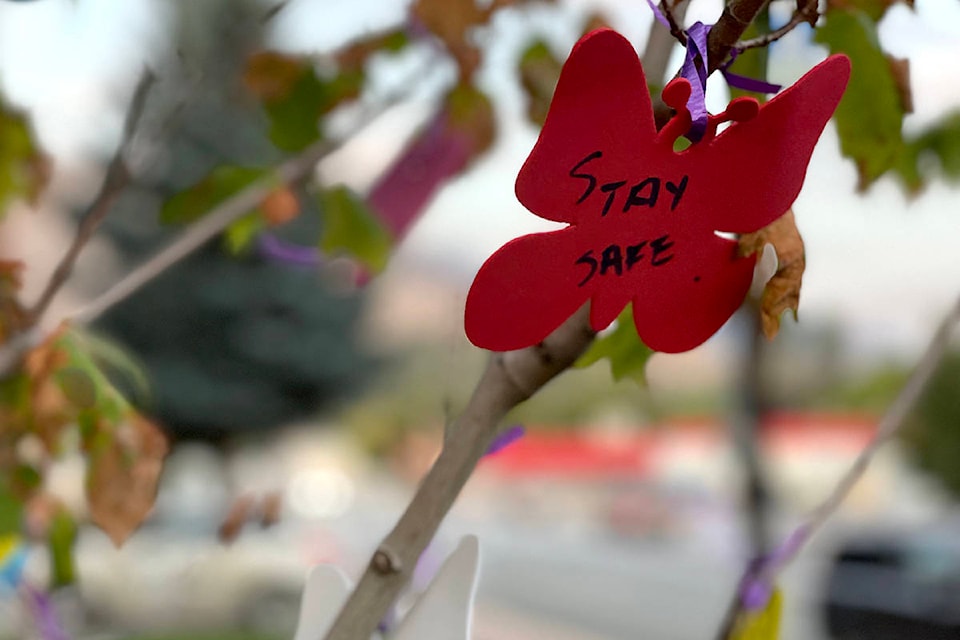People whose lives have been affected by addiction gathered ahead of International Overdose Awareness Day in Grand Forks on Saturday, Aug. 28.
Bereaved friends and family members joined recovering substance users, medical professionals and civic leaders to spread awareness about B.C.’s overdose crisis, officially a public health emergency since April 2016. There was a walk to remember those lost to overdoses, an information session at Grand Forks’ Market on Market and a candlelight vigil.

After all was said and done, event organizers drove home two overarching imperatives: Stemming the harm that comes from substance use and addiction, and ending the stigma that drives the harm.
Dixon Terbasket, an elder and spiritual guide from the Syilx Okanagan National Alliance (ONA), spoke at length to that dynamic within the eight communities that make up the ONA.
“I think it’s largely shame and guilt piled onto past family tragedies,” he told The Gazette, calling attention to the profound “social and economic dislocation” left to the survivors of Canada’s residential school system.

“It’s partly how society views us as Indigenous people,” he continued, drawing on the persistent stereotypes of, “‘The drunken Indian,’ ‘the no-good Indian,’ even though we all work hard as individuals.”
There are people in Indigenous communities who fall into “the black market drug economy,” he acknowledged. But Terbasket explained that non-Indigenous people often overlook the historical context.
“In the history that’s now being told, the Church is being exposed. These things happened to our communities,” he said, highlighting that before residential schools, “We were forced off this land through murder and disease.”
Media attention has dropped off considerably following recent discoveries of countless unmarked graves at former residential schools, many of which were found in B.C., he reminded The Gazette. The inter-generational trauma hasn’t gone away, he said.
The Coroners Service report isn’t broken down in terms of race, but it does show that men are vastly over-represented among the dead. From 2015 through May 31, 2021, between four and four and a half times as many men than women died from drug overdoses in B.C., according to the report.

Locally, Terbasket lost a brother to a fentanyl overdose. So did Mayor Brian Taylor, who shared that story in a speech at Gyro Park Saturday morning.

Event organizers meanwhile set up a Market Avenue booth where a registered nurse trained passersby in how to revive opioid users from an overdose.
When delivered intravenously or through a nasal spray, the medication Naloxone (sold under the brand name NarCan) can temporarily reverse the effects of opioids like fentanyl, heroin and oxycodone (commonly known as Oxy).
It cannot reverse the effects of synthetic benzodiazepines (so-called “benzos”) like Valium and Xanax, meaning that overdoses involving opioids mixed with benzos can often be fatal.

A small crowd held a vigil at Lois Hagan Park (next to City Hall) Saturday evening, where mourners decked a small tree in paper hearts dedicated to people who died from drug overdoses.

Saturday’s events were sponsored by the Grand Forks Community Action Team, an overdose task force that works under the auspices of the AIDS Network Kootenay Outreach and Support Society, and the B.C. organization Moms Stop the Harm.
Naloxone kits are available for free at the Boundary Mental Health and Substance Use Clinic at 7441 2nd St. It is not uncommon in the Interior Health region for street heroin and fentanyl to contain benzos, according to the health authority.
Health Canada defines addiction as a substance use disorder, a “medical condition that often requires treatment from health care providers,” according to the Government of Canada’s website.
One hundred and six people have died of suspected drug overdoses across the Kootenay Boundary area in the last 10 years, according to the Coroners Service report.
International Overdose Awareness Day is marked by communities worldwide every Aug. 31, according to the campaign’s website.
@ltritsch1
laurie.tritschler@grandforksgazette.ca
Like us on Facebook and follow us on Twitter.
laurie.tritschler@boundarycreektimes.com
Like us on Facebook and follow us on Twitter.
